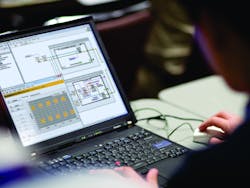Researchers Use Software-Defined Radio for Testing Millimeter-Wave Antennas
The wireless research arm of New York University recently announced plans to build a programmable testbed for prototyping millimeter-wave, or mm-Wave, antennas. The testbed will eventually become available to universities, government agencies, and companies in the early stages of developing mm-Wave products and standards.
The testbed will combine high-gain phased array antennas with a software-defined radio (SDR), in which computer programs replace hardware components like filters and amplifiers. This combination will help to direct millimeter waveforms, which are typically concentrated into narrow beams and pointed directly at other antennas. The testbed is built around a baseband processor that will transmit and receive signals with high data rates and low latency.
The phased-array antenna, which directs signals using electrical cues, complements the nature of mm-Waves. The antennas help “to compensate for the enhanced path loss and to exploit the directionality of the millimeter waveforms,” says James Kimery, the director of RF Research and SDR at National Instruments, which built the baseband processing system. In addition, with the higher frequencies of mm-Waves, the researchers can fit smaller phased-array antennas onto a substrate chip.
Funded by a research grant from the National Science Foundation, the NYU WIRELESS project is the latest sign that wireless companies are building on early progress in mm-Wave components. “There are few, if any, general-purpose millimeter-wave SDRs available today,” says Kimery. The SDR, he says, lends itself to faster prototyping and testing times.
The testbed will be different than current mm-Wave prototyping systems, which are steered mechanically using horn antennas mounted on rotating gimbals. These mechanical systems are sufficient for testing stationary devices, but are generally too slow to keep up with mobile devices, National Instruments said in a statement.
Millimeter waves are expected to be one of the vertebrae in the backbone of 5G communications, providing up to 200 times the capacity of fourth-generation, or 4G, technologies. Because of their highly directional nature, mm-Waves permit antennas to operate in close proximity without causing interference—an imperative for a wireless future in which everyday things are embedded with both near-field and long-range communications chips. In addition, mm-Waves help to optimize spectrum through frequency reuse.
A recent report from Markets and Markets predicts that the entire market surrounding mm-Waves will reach $1.7 billion in 2020. This number is up from around $208.1 million in 2014. Although this technology will have a significant impact on telecommunications, it is also expected to be used in aerospace and defense to enhance radar precision, and imaging and scanning systems in the healthcare and security industries.
The testbed will operate in the unlicensed 60 GHz band, the same as the upcoming Wi-Fi standard IEEE 802.11ad. Millimeter waves are ideal for short-range technologies like Wi-Fi because at certain frequencies they can be absorbed by raindrops or oxygen in the atmosphere over long distances. The result is lower signal strength.
Collaborating with the NYU research team and National Instruments is SiBeam, a subsidiary of Lattice Semiconductor that is providing the RF front end and phased array. The prototyping system is based on National Instruments’ LabVIEW software and PXI modular testing system.
About the Author

James Morra
Senior Editor
James Morra is the senior editor for Electronic Design, covering the semiconductor industry and new technology trends, with a focus on power electronics and power management. He also reports on the business behind electrical engineering, including the electronics supply chain. He joined Electronic Design in 2015 and is based in Chicago, Illinois.
